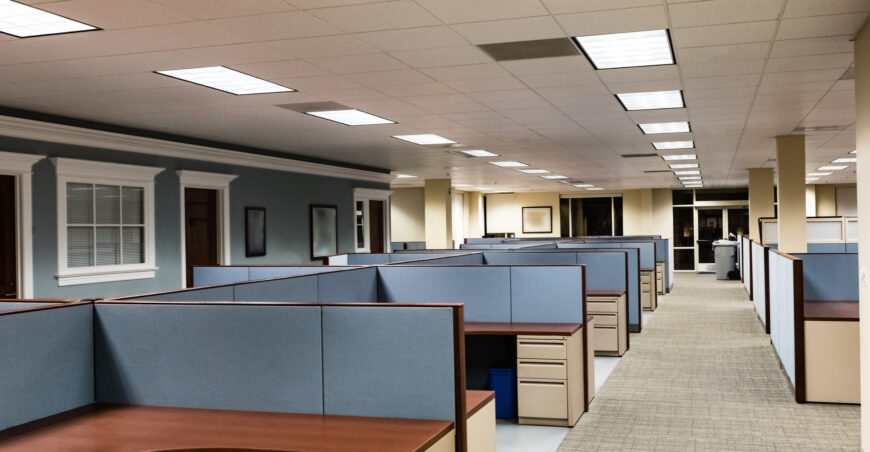The latest reports from JLL help put the current state of vacant commercial office space in perspective, showcasing the 1 billion square feet of empty space across the country. Perhaps the most startling recent news: one of America’s largest office investors – Brookfield Properties – defaulted on a $161 million loan.
Brookfield isn’t the only player in the office space trying to navigate current market struggles. Vacancy rates ranging upwards of 25% have hit many major cities throughout the country. NYC and Washington D.C top the list at the moment, each with 75 million square feet of vacant space.
Vacant Commercial Office Space by U.S. Cities
According to reports released at the end Q1, it’s estimated that 5 to 10 office buildings are at risk of defaulting every month.
Today’s market struggles aren’t completely stopping progress though. Most major cities have notable new square footage under construction. At the end of last year, it was estimated the city of Phoenix alone had nearly 2 million square feet of new space in the works.
Here is a look at current vacancy rates across U.S. commercial office spaces in the top-ranking U.S. cities:
- New York – 75.8M square feet, 16.1% total vacancy
- Washington D.C. – 74M square feet, 20.8% total vacancy
- Chicago – 63.2M square feet, 23.5% total vacancy
- Dallas – 53.5M square feet, 25% total vacancy
- Houston – 49.3M square feet, 25.6% total vacancy
- Los Angeles – 47.1M square feet, 24.1% total vacancy
- New Jersey – 43.3M square feet, 25.8% total vacancy
- Atlanta – 38.1M square feet, 21.6% total vacancy
- Boston – 31.8M square feet, 19.1% total vacancy
- Philadelphia – 27.8M square feet, 18.8% total vacancy
Considering that rates of the typical vacant commercial office space have been trending up since before the pandemic, many investors, owners, and operators in the space are wondering when the lull will come to an end. Higher vacancies, rising interest rates, and a remote work trend likely means we will see continued office struggles throughout 2023. Larger economic factors like inflation will also play a role in office outlook during this cycle.
Additionally, there is market demand to consider. While there are still substantial loans active, it’s estimated that over 50% of the office space under those loans is still unoccupied. Occupancy rates fell below 15% in some regions during the Covid-19 pandemic. Since, most spaces have stabilized in the 40-50% range – still a far cry from healthy levels.
Vacant Commercial Office Space from Banks’ Perspective
We’ve already detailed how vacancy rates are causing some of America’s largest office owners to default on $100 million loans, but banking losses don’t stop there. Office property valuations are expected to fall an estimated 30% during the next year. As a result, commercial loan portfolios will incur a loss upwards of $60 billion.
It should also be mentioned that only 20% of the office space in most commercial districts is owned by big banks. Small to medium sized financial institutions actually make up the majority of loans in the office space. Without large capital reserves, smaller institutions will struggle to keep up with falling property values.
Interest Rates: Impact on Commercial Real Estate
Consumers at every socioeconomic level have felt the effects of rising interest rates, but how are they impacting commercial office space?
Higher interest rates have limited the advancement of portfolios throughout the office sector. As they don’t have the capabilities to keep pace with rising rates, many small to medium sized banks are being squeezed out of the market. This issue is estimated to result in 27% decline in transaction volume for 2023, pushing property values lower and lower.
To deal with interest rate concerns, many institutions are restructuring debt alongside existing loan terms. At this point, short-term extensions are the only means by which many operators can stay afloat.
With more foreclosures looming on the horizon, banks and owners alike are scrambling to find solutions. Without a dramatic shift in market sentiment, there will be a finite number of stakeholders who will be able to weather the storm. That being said, more opportunistic investors and developers are isolating efforts to areas with high potential for growth, and away from the outdated office space that fills much of the market.
Future Outlook for Commercial Office Space
Accounting for current and future economic concerns, it’s difficult to say exactly when the office sector as a whole will recover. Most analysts estimate we will see current vacancy rates continue throughout 2023, with an office recovery coming sometime in the later half of 2024.
But that doesn’t mean there isn’t prime opportunity currently up for grabs either. Phoenix, with just over 25 million square feet of vacant commercial office space, is poised for movement at the very least. Just this last year, ground was broken on the Grove – a 181,494 square foot space situated in the heart of the Camelback Corridor.
Investors have been attracted to sites like the Grove, as they combine office potential with state of the art design and attractive accommodations. If you’re looking for more information on current opportunity in the office space, the ICRE Investment Team would be more than happy to assist. Feel free to reach out with any questions regarding commercial office space or otherwise.
















